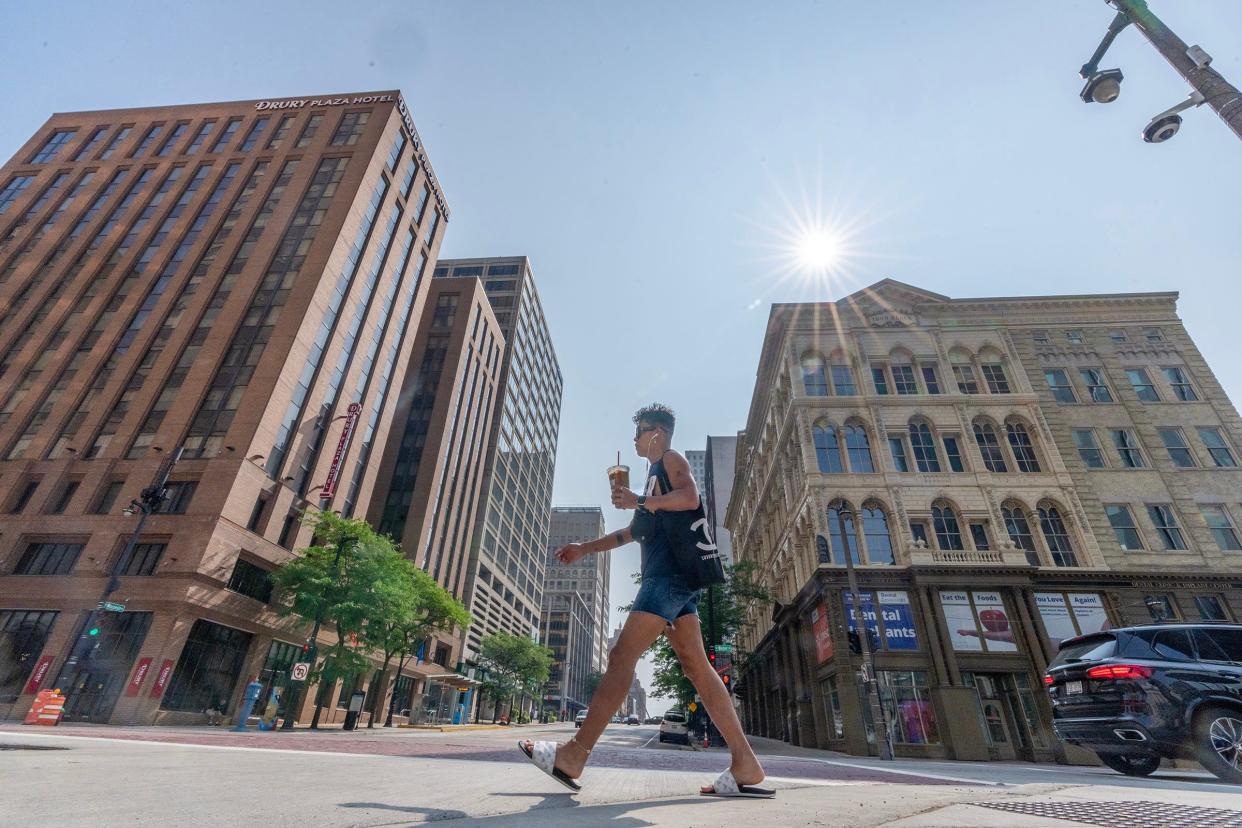Many Milwaukeeans live in a heat island, and 'we can't air condition our way out of this'

New national data has found that when hot summer temperatures descend on Milwaukee and other cities, they can be exponentially higher in certain neighborhoods, dramatically increasing the impact — and danger.
During heat waves, nearly 40% of Milwaukee's residents are exposed to temperatures that are more than 8 degrees hotter than the temperature forecast, according to new data from Climate Central, a nonprofit organization that reports on climate science.
That's a particularly stunning figure for a city on Lake Michigan, which has a massive cooling effect.
Further, the analysis shows that more than 7,000 Milwaukeeans feel temperatures 9 degrees hotter during heat waves, and some places are exposed to temperatures 11 degrees hotter or more.
This variance is called an "urban heat island." Manmade surfaces like parking lots, sidewalks and streets absorb and hold onto heat, creating the effect.
As climate change brings more heat waves, urban heat islands are becoming more apparent, said Wisconsin state climatologist Steve Vavrus.
And in Milwaukee, the hotter zones overlap with the communities that are most vulnerable to the heat, which Vavrus called "a double whammy."
In one of the country's most racially segregated cities, where historical redlining has pushed communities of color into more industrial areas, urban heat islands perpetuate these inequities, said Young Kim, the executive director at Groundwork Milwaukee.
Neighborhoods in heat islands have higher energy costs, air pollution and heat-related illness and mortality.
Turning on an air conditioner isn't a solution for many people in Milwaukee, Kim said. Many houses don't have it, and if they do, the families may not be able to afford the increased costs of using it consistently.
With climate change bringing more heat waves, Kim is worried about what this will mean for many neighborhoods.
"We can't air condition our way out of this," he said.
More than 41 million Americans live near urban heat islands
The new analysis looked at 44 cities across the U.S. and analyzed population data from the 2020 U.S. Census. It also considered factors like tree cover, building height and airflow, as well as how much heat is absorbed or reflected by rooftops.
The analysis shows that around 41 million Americans are living in areas where there are urban heat islands. What's especially troubling, said Kaitlyn Trudeau, a data analyst at Climate Central who worked on the analysis, is that climate change is making the heat variances more dramatic, and therefore more dangerous.
Other cities around the Great Lakes have heat islands as well. In Chicago, more than 52 percent of people are exposed to temperatures that are 8 degrees hotter than the norm. Nearly 11,000 residents experience temperatures 12 degrees hotter.
And in Detroit, more than 85 percent of residents live in heat islands that are 8 degrees warmer.
Heat islands don't dissipate at night
The new analysis tracks with a citizen science project conducted last summer where volunteers mapped Milwaukee, looking for the hottest and coolest parts of the city. The mapping campaign showed that at night there can be a 10 degree temperature difference between the hottest and coolest parts of the city.
During the day, trees and vegetation provide shade, which helps cool surrounding areas. At night, trees and plants cool the air by releasing water to the air and dissipating heat ? a process called evapotranspiration. But manmade surfaces, like concrete and asphalt, don't cool off at night, Vavrus said.
Milwaukee's Bay View neighborhood near Humboldt Park is much cooler at night than downtown and more industrial neighborhoods, like Menomonee Valley and Kilbourn Town.
Heat can be extremely dangerous for vulnerable populations, said Victoria Gillet, a Milwaukee primary care physician. And extreme nighttime heat can actually be deadlier.
Heat can worsen underlying diseases, like chronic kidney and renal disease, Gillet said, because those disease make it harder to regulate the body's water balance.

Heat stroke and illness can happen to anyone, Gillet said, suggesting people take breaks to cool off during the day. She also suggested keeping windows closed and using window dressings, like black-out curtains, that are white on the outside so they reflect the heat and sun.
More and more often, Gillet is finding herself explaining to patients that have lived here for decades that conditions are going to be a lot different now with climate change.
"It's going to get worse as our city heats with climate change," Gillet said.
Health impacts multiply with heat and poor air quality
While cities in the southwestern and southern U.S. have contended with scorching heat over the past few weeks, Milwaukee has seen a relatively pleasant summer — at least when it comes to temperatures.
But this year, a string of air quality alerts from smoke from the record-breaking Canadian wildfires caught Wisconsin off guard. Last month, Milwaukee had air quality levels that ranked among the worst in the world.
The city was under an air quality alert once again this week.
Poor air quality from wildfire smoke mixed with heat can cause the health effects to "multiply," said Gillet.
And extreme heat isn't the only kind of weather that affects some communities more than others. Last year, Groundwork Milwaukee released a report pinpointing the communities most likely to flood during a heavy rain event and how well that community can respond to a flood.
Maps that pinpoint vulnerable areas can help the city decide where to plant more trees, add green infrastructure and prioritize cooling centers.
Is growing the 'green economy' the answer?
The City of Milwaukee and sewerage district have plans in place over the coming years to replace "gray" infrastructure, like asphalt and concrete, with green infrastructure. This can help cool off neighborhoods, soak up water during heavy rain events and keep nearby rivers and lakes clean.
But as organizations, like Groundwork Milwaukee, work to add more green space and "beautify" the city, the balance lies in making sure these efforts don't increase taxes or "unintentionally kick off gentrification," Kim said.
One way to make sure this doesn't happen is by adding jobs and economic opportunities that pay well so people can stay in their homes and improve their climate resilience, by adding better insulation and solar panels, Kim said.
The city is drafting a climate change and equity plan that says one of the ways it will address climate change and racial disparities is by adding more green space and accelerating the growth of green jobs.
"The green economy is coming," Kim said. "People in Milwaukee need to be poised to take advantage of these jobs and economic opportunities."
More: 'This is on our doorstep now': Wildfire smoke a reminder that climate change impacts human health
Caitlin Looby is a Report for America corps member who writes about the environment and the Great Lakes. Reach her at [email protected] or follow her on Twitter @caitlooby.
Please consider supporting journalism that informs our democracy with a tax-deductible gift to this reporting effort at jsonline.com/RFA or by check made out to The GroundTruth Project with subject line Report for America Milwaukee Journal Sentinel Campaign. Address: The GroundTruth Project, Lockbox Services, 9450 SW Gemini Dr, PMB 46837, Beaverton, Oregon 97008-7105.
This article originally appeared on Milwaukee Journal Sentinel: Temperatures can spike in Milwaukee's urban heat islands
Solve the daily Crossword

